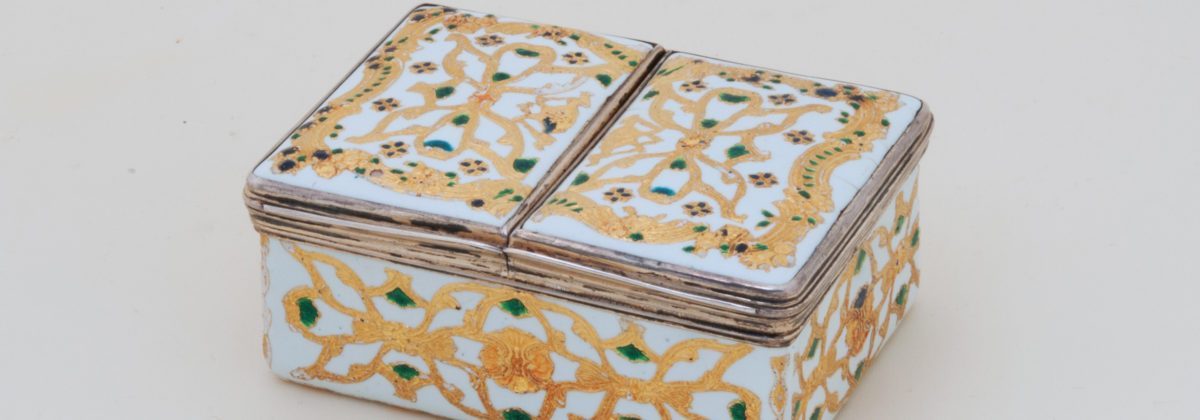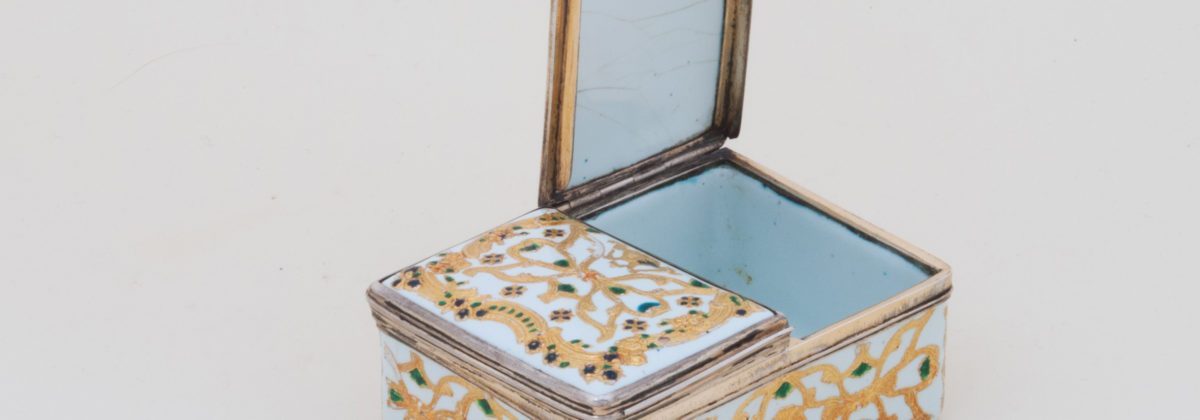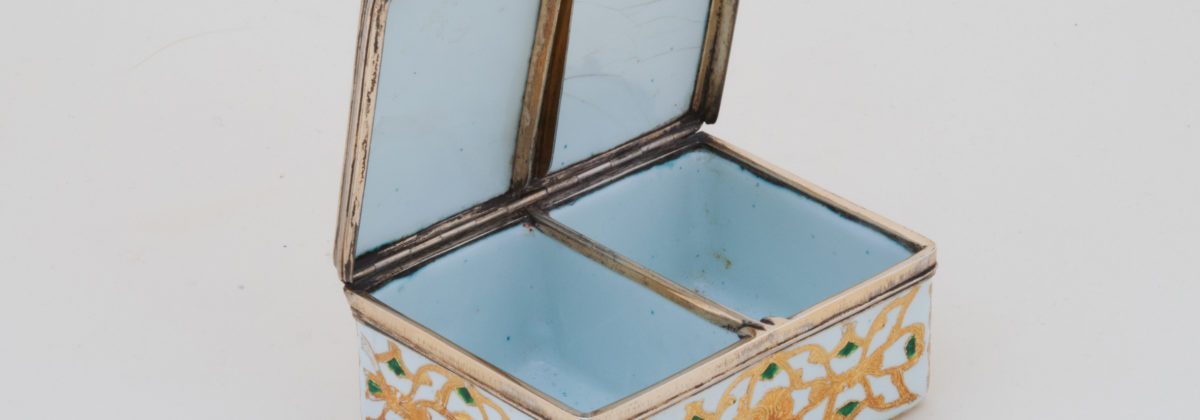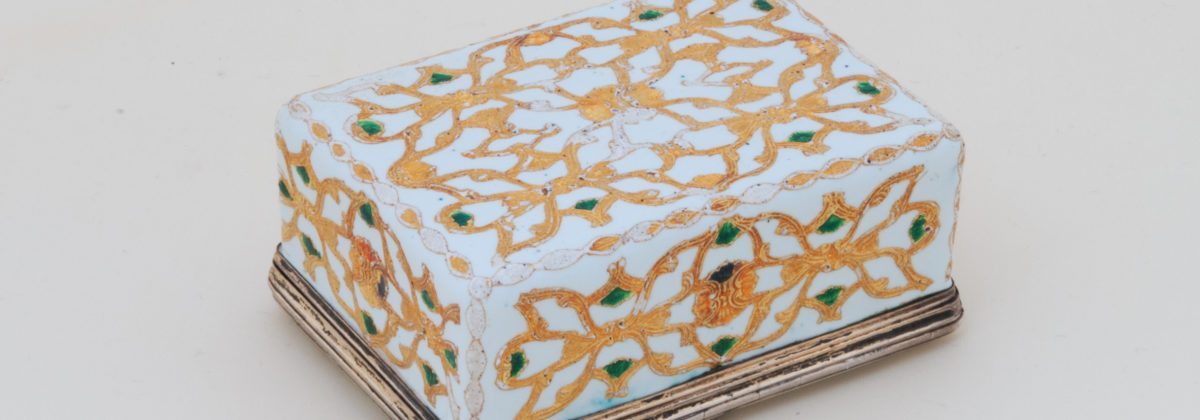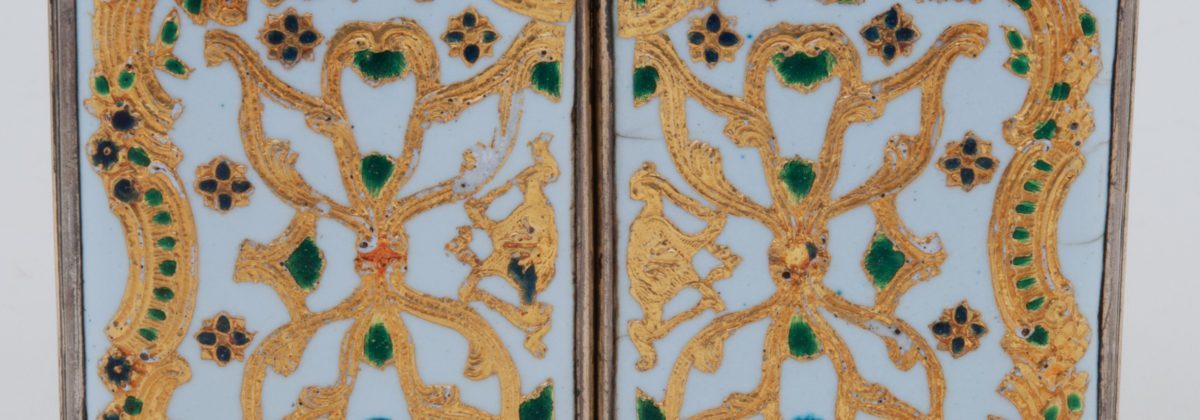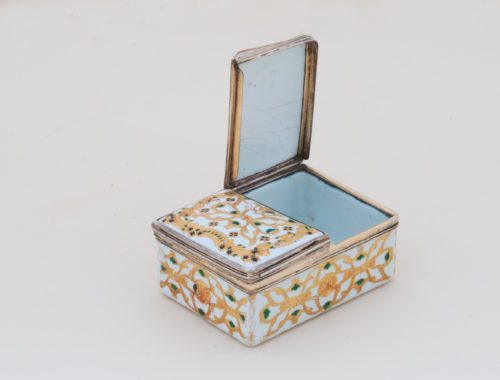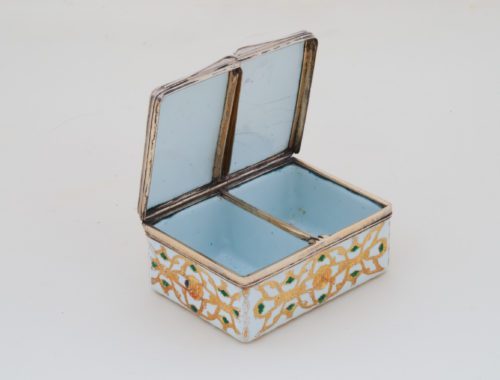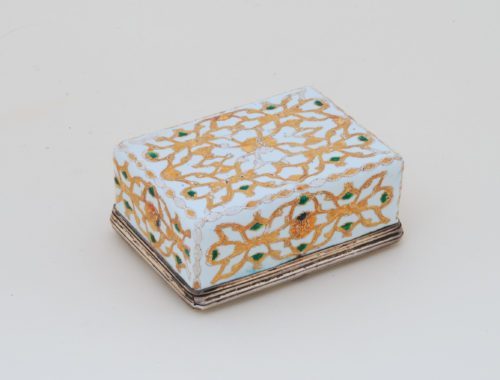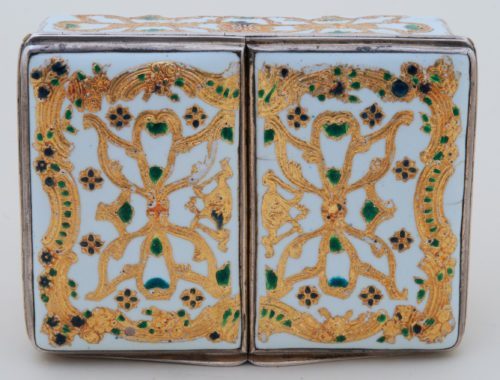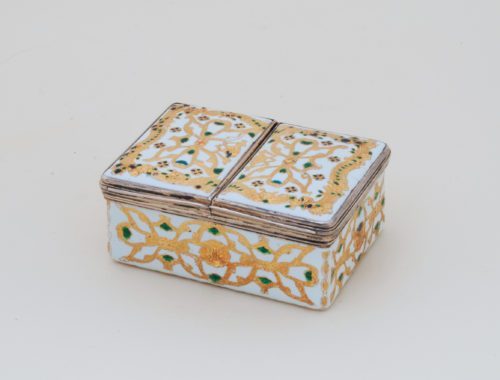Detailed Information
German Enamel Double Snuff Box with Silver-Gilt Mountings
The box has a rectangular form, is mounted with silver hinged covers and has two adjacent compartments. The white enamel has been coated in the inside and outside on a copper surface. On this white enamel, there are applied die-stamped gold foil reliefs. The two hinged covers, the bottom and the lengthy sides are thus adorned in an elegant, rich and elaborated way. On the two hinged covers, there is a kind of frame from rococo scrolls applied. Within, it has been decorated with foliate scrolls and flowers. The bottom and the sides have been decorated with very beautiful strapwork and flowers. All gold foil reliefs are moreover infilled with translucent green, blue and red enamel. In this way, it is given the impression of a decoration with precious stones.
The box is held in a very good condition and has normal traces of usage.
Helga Matzke European Silver shows another snuff box with similar decoration, most probably from the same workshop.
Enamel Luxury Wares
Boxes, namely snuff boxes, which are decorated like this present one, are mostly attributed to the workshop of the Huguenot Pierre Fromery. Pierre Fromery (1655-1738), was an émigré from Franche, who was active in Berlin as an accomplished clock- and boxmaker, steel-cutter and armourer. After the death of Pierre in 1738, his son Alexander (1695-1775) took over the workshop and activities of his father. Alexander was moreover a dealer in luxury wares, who made since 1733 business with the Meissen Porcelain Manufactory (Holzhausen 1930/31, S. 10).
Christian Friedrich Herold (1700-79) worked in the workshop of Fromery, but he joined in 1726 the Meissen Porcelain Manufactory. He then transferred there the technique of the application of gold foils. Besides, C. Fr. Herold has contributed to the development of the refined painting of the Porcelain Manufactory, which he has ennobled and evolved (Holzhausen 1930/31, S. 12). However, C. Fr. Herold was still active for the Fromery workshop despite the protests of the director of the Manufactory.
Wares of toilet sets and boxes with white enamel take the name of “email de Saxe”. Their chief feature is the gold relief foils and the colourful painting on the white enamel surface. This technique was mostly used in Dresden by Dinglinger, in Berlin by the workshop of Fromery and in Augsburg.
In the early eighteenth century, French snuff boxes (tabatières) made of gold and enamel or of other precious materials, were quite fashionably in Germany. These were mostly used for the storage of snuff tobacco, but also of powder, pills and bonbons.
The ascent to power of Frederick the Great (1712-86) meant soon a restriction to their import from France. The goal was to encourage the local production of such wares. Frederick was himself a great collector and user of such snuff boxes, exactly like Heinrich von Brühl (1700-63), the head of the Meissen Porcelain Manufactory.
The production of luxurious wares in Berlin of the eighteenth century was strongly influenced by Parisian examples. A secure attribution of enamel boxes to a specific workshop in Berlin is sometimes difficult, due to the lack of marks or signatures. According to latest research, the hypothesis has been expressed that many enamel parts were made in Berlin and sold in Paris, where they were finally mounted and marked. On this matter, compare two boxes with white enamel and gold foil applications in the Metropolitan Museum of Art, from the Robert Lehman Collection (and The Robert Lehman Collection 2012, cat. no. 72-73/p. 154-155).
For further comparable objects of the same period and made in Berlin workshops, see for instance in the collections of the MAK – Österreichisches Museum für angewandte Kunst: http://sammlung.mak.at/sammlung_online?id=collect-27234.
Literature
Holzhausen, Walter, ‚Email mit Goldauflage in Berlin und Meißen nach 1700’ In: Kunstwanderer, Sept. 1930/1931, S. 4-12.
Klar, Martin, ‚Berliner Galanteriewaren aus Friderizianischer Zeit’ In: Pantheon, Band V, 1930, Jan./Juni, S. 69-72.
Somers Cocks, Anna & Truman, Charles, The Thyssen-Bornemisza Collection: Renaissance Jewels, Gold Boxes and Objets de Vertu, Sotheby Publications/The Thyssen-Bornemisza Collection: London, 1984, Kat. Nr. 91/S. 266-269.
Honour, Hugh und Fleming, John, Lexikon Antiquitäten und Kunsthandwerk, Beck-Prestel: München, 1984.
Koeppe, W., Le Corbeiller, Cl., Rieder, W., et al. (Hrsg.), The Robert Lehman Collection, XV : Decorative Arts, The Metropolitan Museum New York/Princeton University Presse: New York, 2012.
Steingräber, Erich, ‚Email’ In: Reallexikon zur Deutschen Kunstgeschichte, Bd. V (1959), Sp. 1–65; in: RDK Labor, URL: http://www.rdklabor.de/w/?oldid=93187 [25.05.2017].


